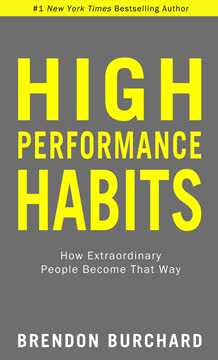Key Takeaways
1. Success is Measured by Lives Touched
We are going to measure success by the way we touch the lives of people.
Redefining success. Traditional business measures like profits and growth are insufficient; true success lies in the positive impact an organization has on the lives of its people. This philosophy shifts the focus from using people for business success to using business as a vehicle for people's fulfillment. It's about creating value for all stakeholders, not just shareholders.
Beyond the numbers. While financial health is necessary for sustainability, it is not the ultimate goal. The real measure is the well-being of employees, customers, suppliers, and communities. This human-centric approach fosters a deeper sense of purpose and meaning within the organization, attracting and retaining people who are motivated by more than just a paycheck.
A moral imperative. Treating people as functions or objects is not only detrimental to long-term business health but is also morally wrong. A business should be a force for good, enriching lives rather than depleting them. Measuring success by lives touched elevates the role of business in society and inspires leaders to act from their deepest sense of right.
2. Leadership is Stewardship
Leadership is an awesome responsibility for the lives entrusted to you.
Beyond management. Leadership is fundamentally different from management. Management is about processes and control; leadership is about caring for people and enabling their growth. Leaders are entrusted with the well-being and potential of those they lead, much like parents are stewards of their children's lives.
Enabling potential. The primary role of a leader is to create an environment where people can discover, develop, share, and be appreciated for their unique gifts and talents. This involves looking for the inherent goodness in people and inspiring them to become their best selves. It's about service, not self-interest.
A higher calling. Seeing leadership as stewardship elevates it to a higher purpose. It means acting with profound respect and care for every individual, recognizing their inherent worth. This perspective transforms the workplace from a place of drudgery to one of meaning and fulfillment, impacting not just employees but their families and communities.
3. Caring Culture Drives Performance
If you take care of your people, they will take care of the business.
The virtuous cycle. Business growth and people growth are interconnected and mutually reinforcing. When leaders genuinely care for their people, employees feel valued, safe, and inspired. This leads to increased engagement, creativity, and productivity, which in turn drives business success and creates opportunities for further people development.
Emotional contagion. A caring culture fosters positive emotions like joy, gratitude, and trust, which are contagious. This creates a vibrant, energetic workplace where people are motivated to help each other succeed. Conversely, fear, distrust, and cynicism are also contagious and deplete organizational energy.
Beyond engagement. It's not enough to simply want employees to be engaged for the sake of productivity. The motivation must be genuine care for their well-being. When people feel truly cared for, their natural desire to contribute and excel is unleashed, leading to extraordinary results that surpass conventional expectations.
4. Trust is the Foundation
Trust is the foundation of all relationships; act accordingly.
Essential for connection. Trust is the bedrock upon which all positive relationships, both personal and professional, are built. Without trust, communication breaks down, collaboration is hindered, and fear and suspicion prevail. Building a high-trust environment is paramount for a healthy and effective organization.
Giving to receive. Leaders must initiate trust by empowering people and giving them freedom, rather than controlling them with excessive rules and surveillance. This demonstrates belief in people's judgment and integrity, which encourages them to reciprocate with trustworthiness and responsible behavior. Practices like time clocks or caged inventory signal distrust.
Building blocks of trust. Trust is built through consistent, authentic behavior. Key elements include:
- Compassion: Showing genuine care and empathy.
- Competence: Demonstrating ability and reliability.
- Consistency: Behaving predictably and fairly.
- Integrity: Doing what you say you will do and aligning actions with values.
5. Process Must Serve People
Machines, systems, and procedures exist to serve people, not the other way around.
Humanizing work. Business processes, often designed for efficiency or control, can dehumanize work and stifle creativity. Continuous improvement methodologies like Lean, when focused solely on waste elimination, can exacerbate this by treating people as interchangeable parts. The goal should be to make processes work for people.
Frustration elimination. Instead of focusing on eliminating waste, focus on eliminating frustration. Listen to the people who do the work; they know the bottlenecks and inefficiencies better than anyone. Empowering them to redesign processes leads to more effective, less frustrating workflows and unleashes their creativity and problem-solving skills.
Wisdom from the front lines. The people closest to the work often possess invaluable wisdom about how to improve it. Engaging them in process improvement events, like Kaizen, not only yields better solutions but also gives them ownership and a sense of purpose. This transforms them from passive participants into active contributors and leaders of change.
6. Cultivate Responsible Freedom
The leader’s role is less to heal or to help than to enlarge the capacity for responsible freedom.
Beyond empowerment. While empowerment is a step, responsible freedom goes further by combining autonomy with accountability. It's the opportunity for individuals to exercise personal choice and ownership over their work, coupled with the responsibility to act with care for others and the organization's goals. This unleashes latent potential.
Freedom from and freedom to. Responsible freedom involves freeing people from oppressive rules, bureaucracy, and excessive hierarchy ("freedom from"). More importantly, it gives them the freedom to innovate, experiment, and contribute their unique gifts ("freedom to"). This requires a strong foundation of shared values and vision.
Lighting fires. Instead of being firefighters who react to problems, leaders should be fire lighters who inspire others. By providing clear goals and responsible freedom, leaders enable individuals and teams to proactively identify opportunities and solve problems. This intrinsic motivation, built on autonomy, mastery, and purpose, is far more powerful than extrinsic rewards or fear.
7. Recognition and Celebration Fuel Goodness
Look for the goodness in people and recognize and celebrate it daily.
Filling the airwaves. In cultures where negativity often dominates, actively seeking out and celebrating goodness is crucial. Recognition and celebration are powerful tools for reinforcing desired behaviors and making people feel valued. They shift the focus from what goes wrong to what goes right.
More than just awards. While formal awards like the GPL SSR Award are impactful, everyday expressions of appreciation are equally vital. These should be personal, sincere, timely, and specific. The goal is not to get more productivity, but simply to let people know they matter and that their contributions are seen and appreciated.
A contagious resource. Recognition and celebration are abundant resources that grow when shared. When people experience the positive feeling of recognizing others, they are motivated to do it more often. This creates a culture of giving and appreciation, fostering stronger bonds and a more positive work environment.
8. Educate Leaders for Transformation
We believe that we can use the power of business to dramatically impact the world in a positive way.
Beyond skills. Leadership education should aim for personal transformation, not just skill acquisition. It's about helping individuals understand their impact on others and inspiring them to embrace the awesome responsibility of leadership in all aspects of their lives, not just at work.
Internal wisdom. Leveraging internal team members as professors creates authenticity and relevance. Their personal stories and experiences resonate deeply with participants, demonstrating that truly human leadership is achievable within the organization. This also provides a valuable development opportunity for the professors themselves.
Feeding the hungry. Focusing educational resources on those who are intrinsically motivated and eager to learn maximizes impact. An opt-in model ensures participants are engaged and receptive, becoming ambassadors for the culture and inspiring others to seek out learning opportunities. This creates a virtuous cycle of growth and cultural diffusion.
9. Courageous Patience is Key to Change
You must be patient with people, because you don’t know what they have been through.
Overcoming the past. Many people carry baggage from past negative experiences in the workplace, leading to cynicism and distrust. Cultural transformation requires courageous patience – the willingness to invest time and effort in rebuilding trust and showing people that things are truly different, even when they are resistant.
Driving the bus. Change doesn't happen overnight. It's like driving a bus around the block, patiently waiting for people to feel safe and ready to hop on board. Leaders must remain steadfast in their vision and values, consistently demonstrating their commitment, even when progress is slow.
Transformative potential. Individuals who were once the most cynical or resistant can become the most passionate advocates for the culture once they experience genuine care and trust. Their transformation serves as a powerful inspiration to others, demonstrating that change is possible and worth the effort.
10. Vision Guides the Journey
A clear and compelling vision, embodied within a sustainable business model, which fosters personal growth.
The lighthouse. A clear vision serves as a beacon, guiding the organization towards a compelling future. It articulates the purpose and values, providing direction and inspiring all stakeholders. A strong vision is essential for making decisions that are consistent with the desired culture, especially during challenging times.
People-centric vision. While business vision often focuses on products or market position, a truly human vision centers on the impact on people's lives. It describes what it will look and feel like for everyone in the organization when the vision is achieved, fostering a sense of shared purpose and belonging.
Engaging the organization. Visioning is a collaborative process that involves people from across the organization. This builds ownership and ensures the vision reflects collective aspirations. Translating the vision into actionable plans and consistently communicating progress keeps everyone aligned and motivated.
11. Acquisitions as Adoptions
We acquire businesses where our experience would indicate that we can create value for all stakeholders.
Beyond financial engineering. Acquisitions should be viewed as opportunities to spread a positive culture and create value for all stakeholders, not just financial buyers seeking quick profits. This involves a "buy, build, and hold" philosophy focused on long-term sustainability and human flourishing.
Seeing potential. Truly human leaders see potential for value creation in challenged businesses that others overlook. They believe in the people already there and commit to working with them to build a better future, rather than replacing them. This approach leverages existing knowledge and fosters loyalty.
Immediate demonstration. Upon acquisition, it's crucial to quickly demonstrate that things will be different by taking tangible actions aligned with the people-centric vision. Listening to employees, addressing long-standing frustrations, and empowering them to make improvements builds trust and signals a new era of caring leadership.
Last updated:
Review Summary
Everybody Matters receives mostly positive reviews, with readers praising its inspirational message about valuing employees and creating a people-centric business culture. Many appreciate the practical examples and leadership principles shared by Chapman. Some critics find the book repetitive or too focused on the author's company. Reviewers highlight the book's emphasis on treating employees like family, fostering trust, and measuring success by improving people's lives. While some readers find the approach idealistic, many are inspired to apply these concepts in their own workplaces.
Similar Books










Download PDF
Download EPUB
.epub digital book format is ideal for reading ebooks on phones, tablets, and e-readers.





